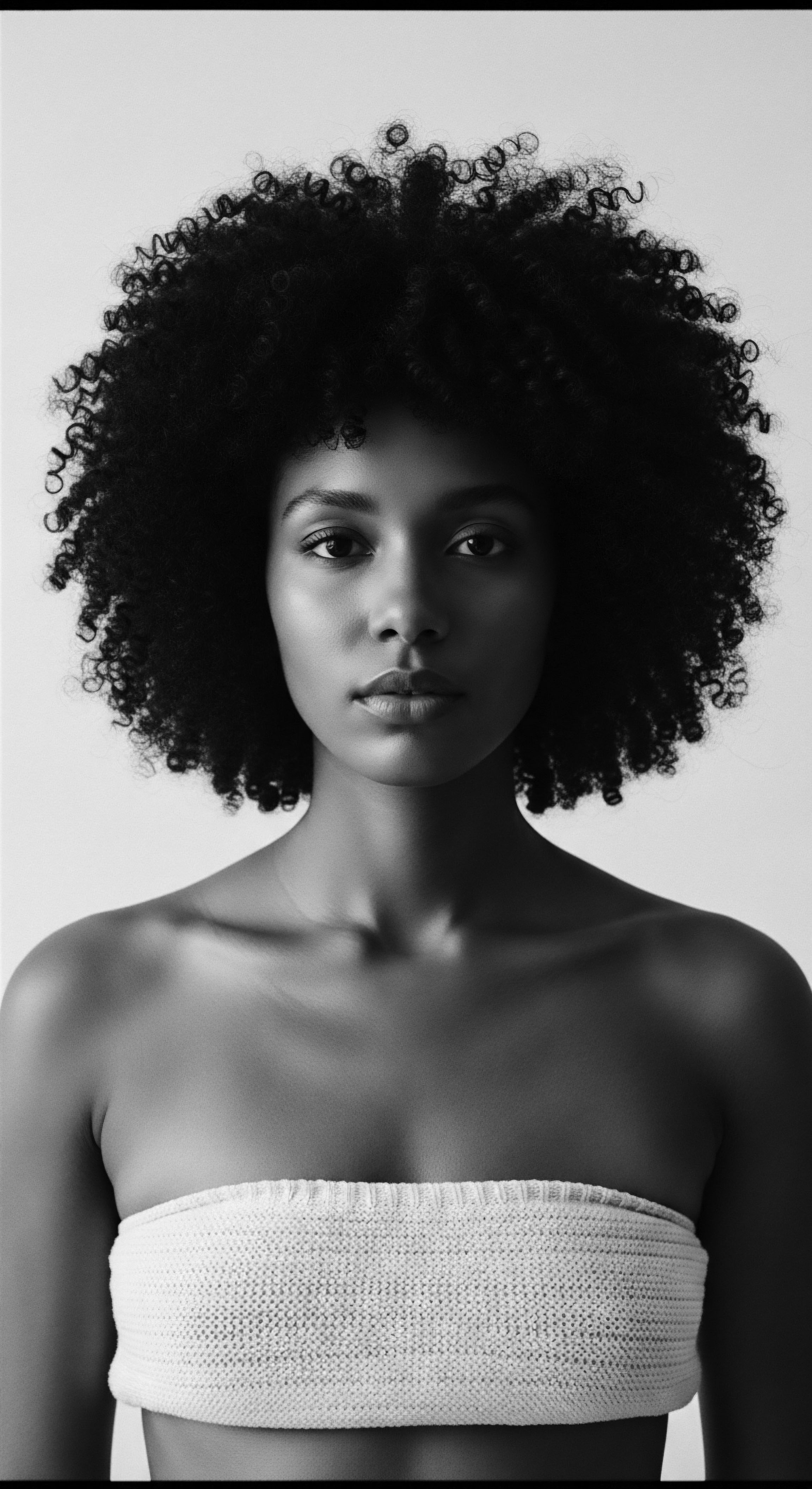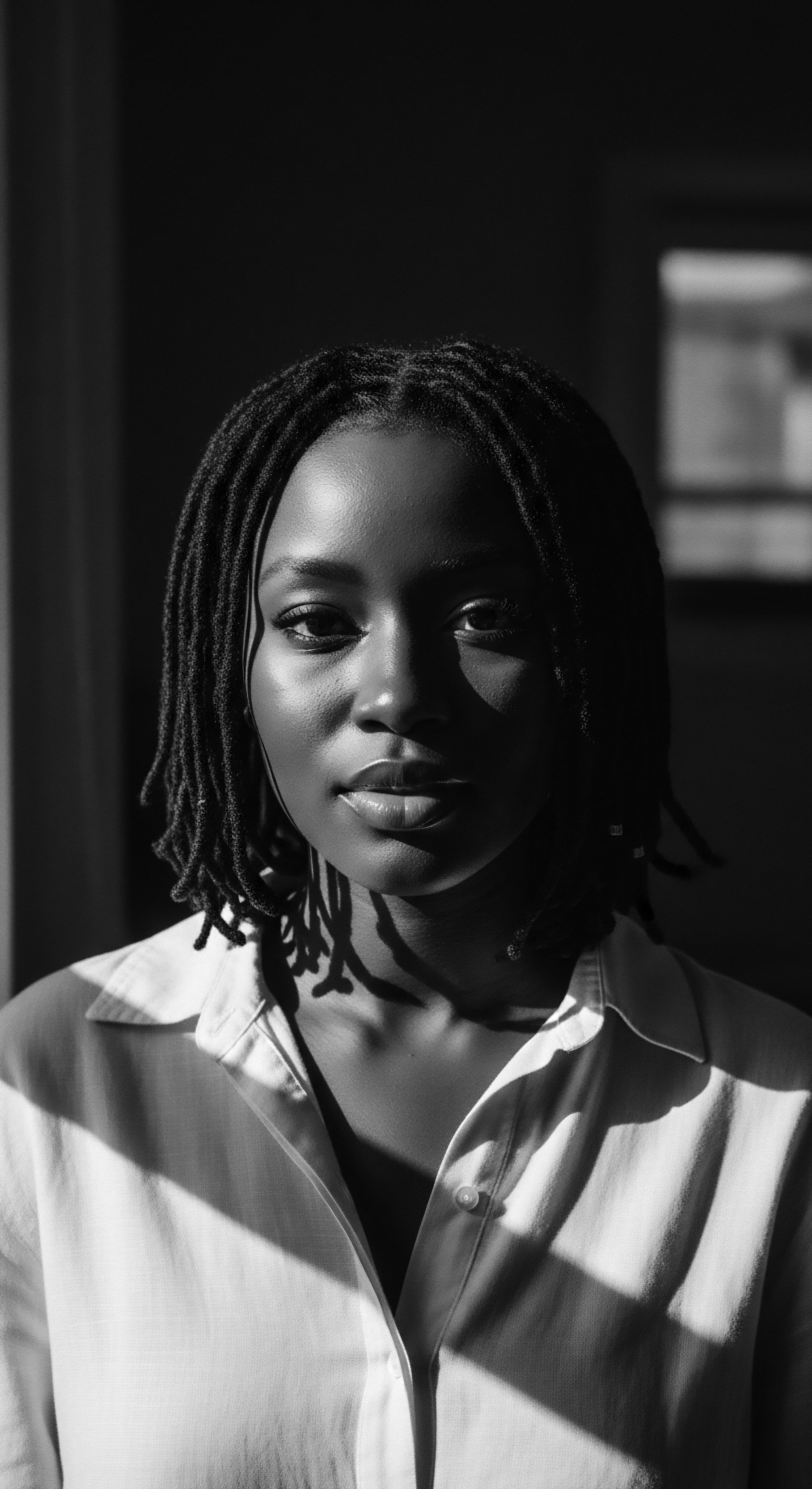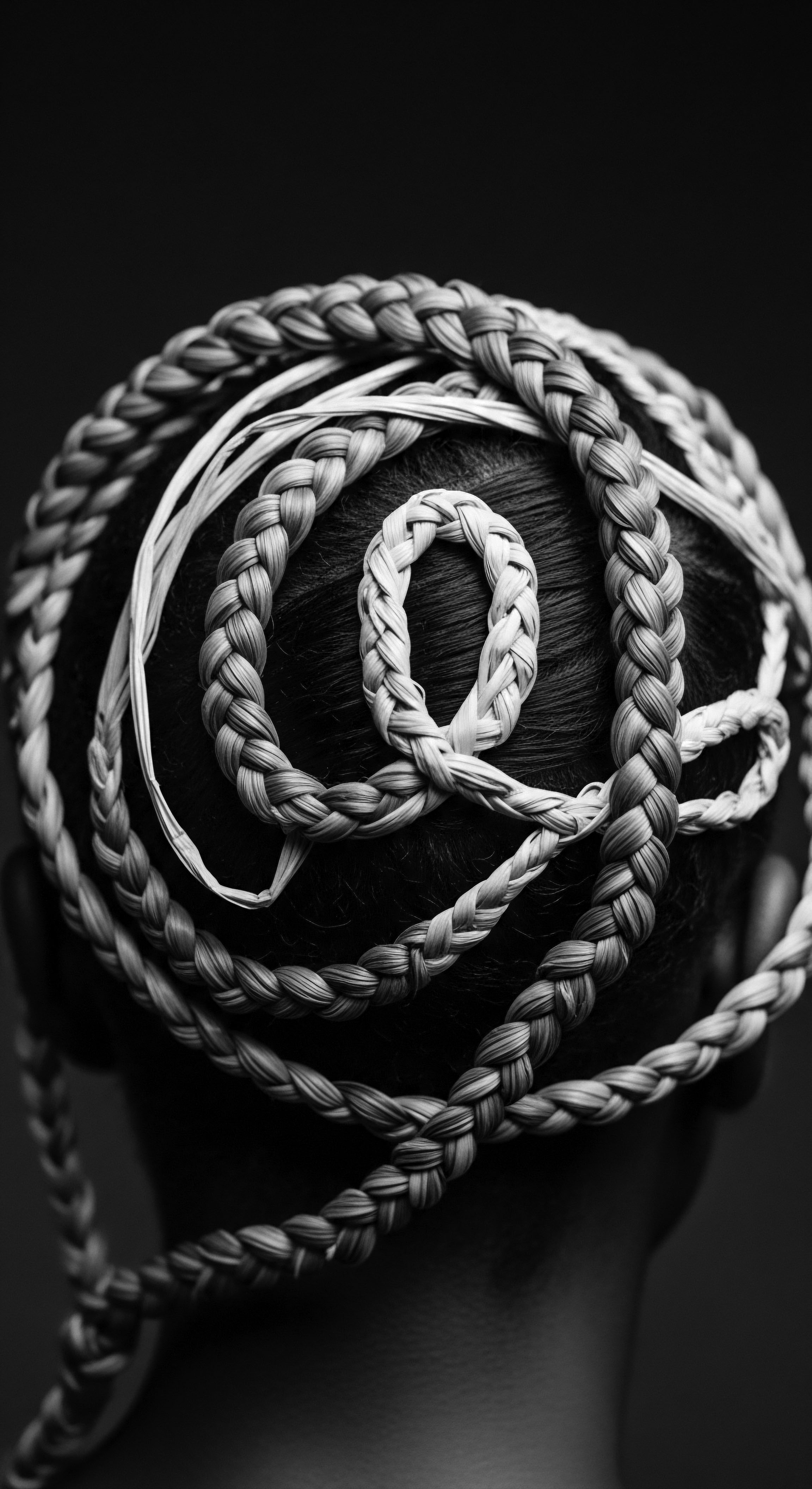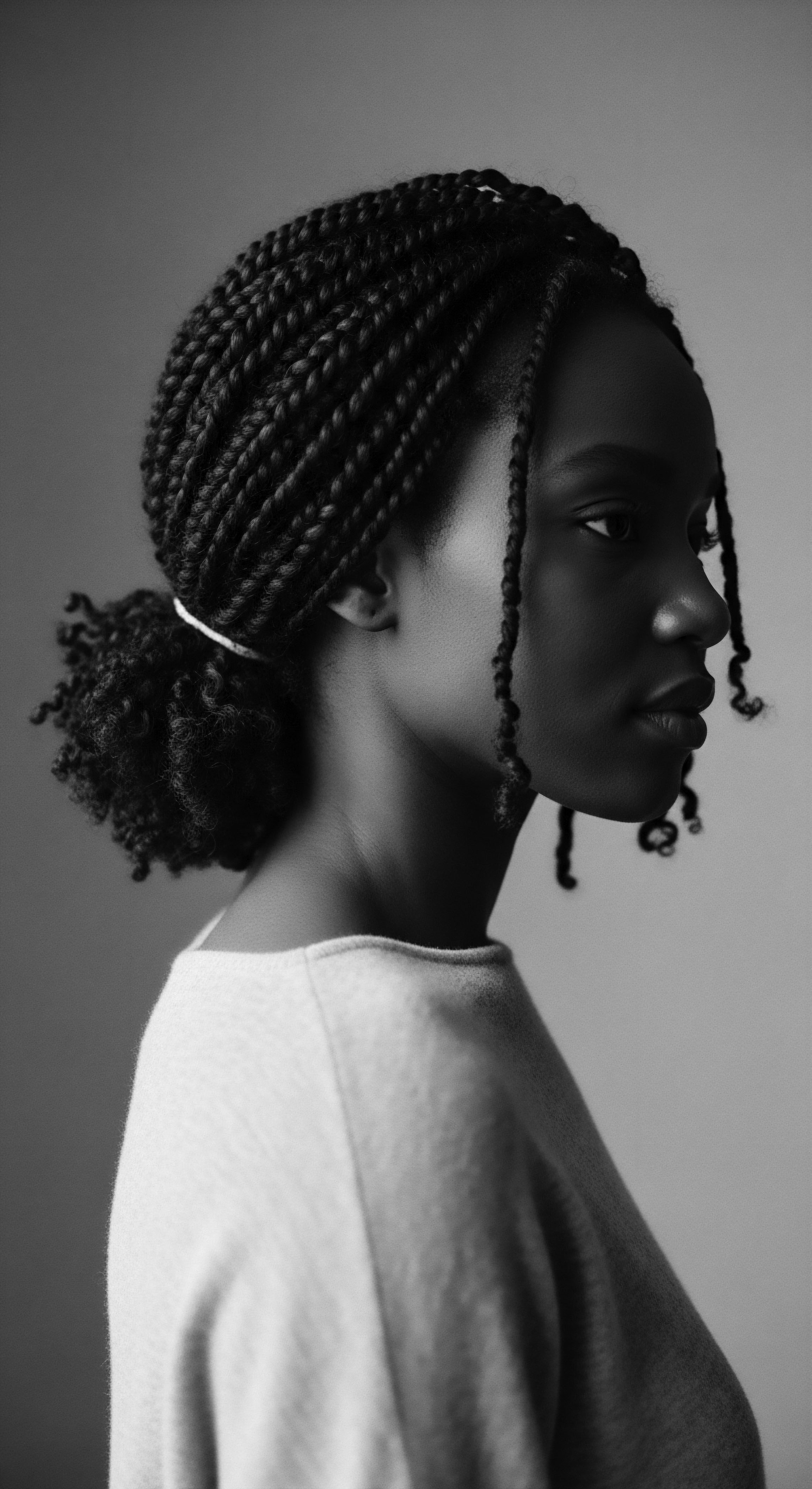
Fundamentals
The fundamental explanation of what we name ‘Styling Tools’ unveils itself as a concept far deeper than simple implements of adornment or manipulation. At its very heart, a styling tool represents any device, instrument, or even a practiced human gesture employed to shape, arrange, or alter the natural presentation of hair. This understanding holds significance for all hair textures, yet its meaning transforms, deepens, and becomes intrinsically bound to lineage when we consider the diverse needs and historical trajectories of textured hair, particularly within Black and mixed-race communities. The very act of styling, often perceived as a contemporary pursuit, carries echoes from the source of human ingenuity, mirroring ancestral practices that recognized hair as a conduit for spiritual connection, social status, and personal expression.
In its simplest form, a styling tool is an extension of intention, designed to facilitate a desired appearance. Consider the early history of humanity; the human hand served as the initial, most immediate instrument for grooming and shaping. Fingers deftly separated coils, gently smoothed strands, or twisted locks into formations that conveyed meaning.
These primordial styling actions, though seemingly rudimentary, laid the groundwork for sophisticated techniques that would arise. They were the genesis of an ongoing dialogue between human creativity and hair’s inherent structure.
Across various ancestral traditions, especially within African societies, the earliest styling tools were born from the natural world, crafted with an intuitive understanding of hair’s properties and the surrounding environment. Materials like carved wood, bone, natural gourds, and even specific leaves were transformed into implements. These weren’t simply utilitarian objects; they were often imbued with spiritual significance, passed down through generations, and treated with reverence. The designation ‘styling tool’ here encompasses not just the physical object, but the collective knowledge and skilled application that accompanied it, often within a communal setting.
The fundamental essence of a styling tool lies in its capacity to translate human intention into hair’s tangible presentation, reflecting ancient practices and profound cultural significance.

The Primal Touch ❉ Hands as the First Instruments
Before any artifact emerged from the earth or was shaped by skilled hands, the human fingers were the quintessential styling implements. This initial, intuitive engagement with hair formed the bedrock of all subsequent practices. The very act of separating, twisting, coiling, and patting hair into place with one’s own hands or the hands of a loved one held a particular significance, especially in communal grooming rituals.
It was a bonding experience, a transfer of care and knowledge, and a tangible expression of affection and belonging. This hands-on approach persists today in many natural hair styling techniques, acknowledging an unbroken lineage of touch.
This primary engagement with hair, requiring intimate knowledge of its texture and elasticity, laid the cognitive framework for more complex tools. The fingers learned to discern the specific needs of individual strands, to understand how best to manipulate them without causing damage, and to predict how they would settle. This ancestral understanding forms the foundation for modern hair care, emphasizing gentle manipulation and an appreciation for hair’s natural state. It is a testament to the enduring power of elemental biology and ancient practices, serving as a powerful echo from the source of hair wisdom.

Shaped by the Earth ❉ Natural Materials as Early Aids
As human societies evolved, so too did the sophistication of their styling aids, drawing inspiration and materials directly from the environment. From ancient Kemet to various West African kingdoms, the ingenuity displayed in crafting hair implements was remarkable. The delineation of ‘styling tools’ in these contexts broadens beyond the mere instrument to encompass the entire system of knowledge surrounding their creation and proper application.
- Combs Carved from Wood ❉ Often imbued with symbolic meaning, these early combs were not just for detangling but for creating parts, lifting, and shaping hair into intricate designs. Their teeth were designed with the unique density and curl patterns of textured hair in mind.
- Bone Pins and Skewers ❉ Employed for securing elaborate styles, for creating braids, or for sectioning hair, these items doubled as adornments, signaling status or marital state within certain communities.
- Natural Fibers for Extensions ❉ Techniques involving the integration of plant fibers or animal hair into natural hair for added length or volume speak to an ancient understanding of augmentation and protective styling, predating modern weaves by millennia.
- Gourds and Shells ❉ Often used as vessels for mixing natural conditioners or oils, their smooth surfaces also served as gentle tools for applying products or even smoothing certain sections of hair.
The statement ‘styling tool’ from this vantage point represents a profound connection to the land and its offerings, a reflection of a people living in harmonious interaction with their surroundings. These tools were not mass-produced; each piece often held a unique story of its creation, its purpose, and the hands that used it. The enduring meaning of these instruments, their fundamental import, speaks to a holistic approach to hair care where tools, nature, and community were inextricably linked.

Intermediate
Progressing beyond the foundational understanding, the intermediate meaning of ‘Styling Tools’ requires a deeper exploration of their historical evolution, their role in shaping cultural aesthetics, and the nuanced interplay between human ingenuity and hair’s biological complexities. This perspective acknowledges that styling implements are not static objects but rather dynamic agents within the continuous story of textured hair. They serve as tangible links to our collective past, simultaneously reflecting societal shifts and individual expressions of identity. The significance of these implements extends into the very fabric of communal life, especially for Black and mixed-race people, where hair rituals have long been cherished traditions.
The definition of ‘styling tool’ expands to encompass not just the physical artifact, but the associated techniques, the knowledge passed down through generations, and the cultural context that gives them purpose. Consider the development of specialized combs and picks designed to navigate the unique architecture of coiled and kinky hair. These were engineered not for tension or breakage, but for gentle separation and lift, celebrating volume and form.
This marked a departure from mere grooming to intentional shaping, a conscious act of defining one’s appearance through the manipulation of hair. The interpretation of ‘styling tool’ thus becomes a descriptor of cultural adaptation and self-definition.

Weaving Threads of Time ❉ Early Innovations and Communal Practices
The tender thread of hair care, stretching back through the ages, saw innovations in styling implements that speak to an enduring commitment to aesthetic and holistic wellbeing. In many African societies, the preparation and adornment of hair were communal rites, often spanning hours. The tools employed were therefore designed to facilitate comfort, efficiency, and artistic expression within these lengthy processes. The clarification of ‘styling tools’ in this context highlights their role as enablers of social interaction and the transmission of embodied knowledge.
For instance, the sophisticated combs unearthed from ancient Egyptian tombs, crafted from ivory or wood, possessed fine, closely spaced teeth on one side for intricate parting and wider-spaced teeth on the other for gentle detangling. These implements were integral to the creation of elaborate braided and wigged styles, reflecting status and often depicting religious or symbolic narratives. The delineation of these tools signifies a precise understanding of hair’s properties and the desire to manipulate it with precision, honoring both its natural state and its potential for artistic transformation.
Styling tools evolved beyond mere function, becoming symbols of cultural exchange, social status, and communal bonding across generations.
| Tool Category Carved Wooden Combs |
| Description and Traditional Use Used for detangling, parting, and shaping hair into complex patterns. Often held symbolic meaning, depicting figures or ancestral motifs. |
| Contemporary Parallel/Significance The modern wide-tooth comb or Afro pick, prioritizing gentle detangling and volume, echoes the design and function of these ancestral implements, affirming a lineage of care. |
| Tool Category Bone or Ivory Pins |
| Description and Traditional Use Served as fasteners for elaborate styles, braiding aids, and decorative elements. Signified social standing, rites of passage, or tribal identity. |
| Contemporary Parallel/Significance Hairpins, clips, and decorative accessories used today for securing styles or adding embellishment, demonstrating a continuous practice of hair ornamentation. |
| Tool Category Natural Fiber Threads |
| Description and Traditional Use Employed for wrapping, threading, or banding hair to stretch, protect, or create specific coiled formations without heat. |
| Contemporary Parallel/Significance Modern banding, stretching, or threading techniques, often using elastic bands or yarn, reflect ancestral wisdom for preserving hair health and achieving length without damaging thermal styling. |
| Tool Category These ancestral tools, while physically distinct from modern equivalents, share a common spirit ❉ a deep understanding of textured hair and a dedication to its holistic wellbeing and expressive potential. |

Beyond Utility ❉ Tools as Cultural Vessels
The meaning of styling tools extends beyond their practical applications to their profound role as vessels of cultural memory and identity. In the African diaspora, especially following the transatlantic slave trade, the continuity of hair practices, even under oppressive conditions, became an act of profound resilience and resistance. Simple combs fashioned from salvaged materials, or the continued use of hands, became potent symbols of heritage and continuity. This historical context underscores the deep import of these tools as instruments of self-preservation and communal solidarity.
The development of new styling implements, or the adaptation of existing ones, often reflected a complex negotiation of identity. Hair, as a visible marker of heritage, became a contested terrain. Styling tools, in this light, represent the tangible means by which individuals and communities asserted agency over their appearance, whether conforming to or subtly subverting dominant beauty standards. The enduring sense these tools carry is one of adaptive survival and the persistent pursuit of beauty, even in adversity.
- Combs as Markers of Identity ❉ Specific comb designs or the way a comb was used could signal group affiliation, marital status, or even readiness for initiation rituals in traditional African societies.
- Adornments as Communication ❉ Tools used to attach shells, beads, or cowries to hair were part of a complex visual language, communicating wealth, social standing, or spiritual beliefs.
- The Legacy of Hands-On Care ❉ The continued emphasis on manual manipulation of hair, whether through braiding, twisting, or finger-coiling, speaks to an inherited wisdom that values gentle, intentional interaction with hair’s natural form.
The clarification of ‘styling tool’ at this intermediate level recognizes its dual function ❉ a practical implement and a cultural artifact. Each tool holds a story, a memory, and a connection to the generations who shaped hair with care, creativity, and a profound respect for its heritage.

Academic
The academic definition of ‘Styling Tools’ transcends a mere cataloging of implements; it requires a rigorous, multi-layered examination that positions these instruments within a complex framework of socio-cultural dynamics, historical materialism, and the embodied knowledge systems of Black and mixed-race communities. It demands a nuanced interpretation of their significance, exploring their role as mediators between human intention and corporeal presentation, particularly as they pertain to the unique biophysical properties and cultural meanings of textured hair. This intellectual pursuit seeks to delineate the profound interplay between technology, identity, and power structures, recognizing styling tools as material artifacts that both shape and are shaped by broader societal narratives. The explication of ‘styling tools’ from this perspective necessarily involves an interdisciplinary lens, drawing from anthropology, material culture studies, sociology, and critical race theory.
The meaning of ‘styling tool’ at this advanced level acknowledges its capacity to act as a significant agent in the construction and deconstruction of aesthetic ideals. These tools are not neutral. They carry the imprints of economic forces, colonial legacies, and resistance movements.
Their substance, their form, and their prescribed methods of application are deeply embedded in historical contexts, often reflecting dominant beauty paradigms while simultaneously serving as instruments of subversion and self-determination. The designation of ‘styling tool’ thereby refers to a dynamic object, one whose purport and function are continuously renegotiated through cultural practice and intellectual inquiry.

A Legacy Forged ❉ The Sociological Contours of Styling Implement
From an academic vantage point, the development and dissemination of styling implements for textured hair can be understood as a series of responses to both inherent hair characteristics and external socio-political pressures. The inherent elasticity and curl memory of textured hair necessitate specific approaches to manipulation, leading to the early development of tools that prioritized sectioning, coiling, and gentle stretching. Yet, the historical trajectory of many styling tools, particularly in the post-slavery diaspora, became inextricably linked to the pervasive influence of Eurocentric beauty standards. This nexus represents a critical juncture in the interpretation of their historical significance.
One particularly illustrative example of this complex interplay is the emergence and socio-cultural impact of the hot comb within Black American communities. While antecedents to the hot comb existed in various forms (e.g. heated irons for hair straightening in 19th-century Europe), its widespread adoption and transformation into an accessible styling implement for Black hair in the early 20th century represents a powerful case study in the negotiation of identity and aesthetics under racialized conditions. Madame C.J.
Walker (born Sarah Breedlove, 1867-1919), though often misattributed as its sole inventor, undeniably played a paramount role in popularizing and refining a system of hair care that included the hot comb, making it commercially viable and instructing Black women on its use. Her ‘Walker System’ of hair straighteners and hot combs provided a means for Black women to achieve a straightened hairstyle that was perceived by some as a pathway to greater social and economic mobility in a racially stratified society.
The hot comb, a metal comb heated over a stove, offered a temporary alteration of curl pattern, achieving a straightened appearance. Its initial import was often framed within discourses of respectability and assimilation, offering Black women a way to conform to prevailing beauty norms that valorized straight hair. This was not a simple act of styling; it was a complex social phenomenon. As Byrd and Tharps (2001) observe, “The hot comb represented a powerful, if sometimes fraught, tool for self-presentation, a complex response to the social and economic pressures of the era.” The widespread use of the hot comb, though enabling access to certain social spheres, also contributed to internal debates within the Black community about authenticity, beauty standards, and racial identity.
Its presence in countless Black households solidified its role as a key instrument in the private rituals of Black womanhood, shaping a particular aesthetic for generations. The designation of ‘styling tool’ here encompasses the intricate web of societal expectations and personal aspirations.
The hot comb’s historical prevalence in Black communities encapsulates the intricate negotiation of identity and aesthetics under societal pressures, transcending mere function to embody a profound cultural statement.

Theoretical Lenses ❉ Deconstructing the Tool’s Meaning
Applying a material culture lens to styling tools reveals them as more than inert objects; they are active participants in cultural production. The design, dissemination, and reception of these tools, particularly for textured hair, reflect broader historical and sociological trajectories. The process by which a natural material becomes a comb, or a heated piece of metal becomes a hot comb, is not arbitrary.
It is influenced by available resources, technological advancements, and crucially, by prevailing aesthetic and social hierarchies. The clarification of ‘styling tool’ from this perspective emphasizes its embodiment of historical agency.
Furthermore, a critical race theory perspective highlights how styling tools have been implicated in systems of racialized beauty. The very notion of “good hair” often contrasted with the inherent texture of Black hair, leading to the development and preference for tools and techniques that facilitated a European aesthetic. The hot comb, for instance, became a symbol of this tension, offering a means of temporary conformity while simultaneously evoking discussions about self-acceptance and natural beauty.
However, it is also important to acknowledge that for many, the hot comb was a tool of empowerment, allowing for diverse styles and personal expression within the context of their time. This duality complicates a simplistic understanding, pushing for a more nuanced interpretation of its meaning and use.
This academic scrutiny of styling tools demands a deconstruction of their purported neutrality. The ‘Styling Tools’ meaning extends to their role as agents of cultural transmission, carrying forward techniques and aesthetic preferences across generations. Conversely, they can also represent disruptions, introducing new methods that challenge traditional practices. The sustained engagement with these objects provides a tangible pathway to understanding the fluid, evolving nature of textured hair care practices, and how they mirror the larger historical arc of Black and mixed-race experiences globally.
- Power Dynamics and Aesthetics ❉ Styling tools can either reinforce or challenge dominant beauty standards, reflecting ongoing struggles for self-definition within marginalized communities.
- Technological Determinism Vs. Cultural Agency ❉ Examining whether tool development dictates hair trends, or if cultural needs drive tool innovation, offers a deeper interpretation of ‘styling tool’ as a concept.
- The Semiotics of Hair Implements ❉ Analyzing how specific tools, such as the hot comb or traditional African picks, acquire symbolic meanings beyond their primary function, becoming signifiers of identity, resistance, or assimilation.
The academic definition of ‘Styling Tools’ therefore culminates in an understanding of these items as complex cultural artifacts. Their profound import lies in their capacity to embody history, mediate social relations, and serve as critical instruments in the ongoing conversation about textured hair, its ancestral legacy, and its continuous evolution. Each instrument, each technique, each moment of styling with these tools contributes to a rich, living archive of human experience.

Reflection on the Heritage of Styling Tools
The journey through the meaning and legacy of Styling Tools reveals a narrative far richer than simple utility. It is a profound meditation on the enduring spirit of textured hair, its ancestral wisdom, and the unbreakable bond between human ingenuity and natural form. From the skilled hands that first coiled and braided strands, to the intricately carved combs passed down through generations, and even to the complex story of the hot comb, these instruments are not mere objects. They are tangible echoes of countless hands, countless stories, and countless moments of care, creativity, and resilience.
The wisdom embedded within these tools, both ancient and modern, reminds us that styling is rarely just about appearance; it is about self-affirmation, cultural continuity, and an ancestral inheritance. The tender thread of care, woven through centuries, connects us to those who came before, reminding us that every twist, every coil, every carefully separated strand is a whisper from the past, a celebration of the present, and a blueprint for the future. The very act of engaging with styling implements, with intention and respect for hair’s unique heritage, becomes an act of profound self-love and communal remembrance.
The unbound helix of textured hair, with its remarkable versatility and strength, finds its voice through these tools. They allow for an infinite array of expressions, honoring the diverse histories and vibrant identities that Black and mixed-race hair represents. In each tool, from the simplest pick to the most technologically advanced dryer, resides a legacy of adaptation, innovation, and an unwavering commitment to the beauty that springs forth from our roots. This understanding allows us to approach our hair, and the tools we use to care for it, with a reverence that acknowledges its deep cultural meaning and its sacred place within our personal and collective narratives.

References
- Bundles, A. (2001). On Her Own Ground ❉ The Life and Times of Madam C.J. Walker. Scribner.
- Byrd, A. D. & Tharps, L. L. (2001). Hair Story ❉ Untangling the Roots of Black Hair in America. St. Martin’s Press.
- Mercer, K. (1994). Welcome to the Jungle ❉ New Positions in Black Cultural Studies. Routledge.
- Tharps, L. L. & Byrd, A. D. (2014). Hair Story ❉ Untangling the Roots of Black Hair in America. St. Martin’s Griffin.
- White, S. (2005). Stylin’ ❉ African American Expressive Culture from Its Beginnings to the Zoot Suit. Cornell University Press.
